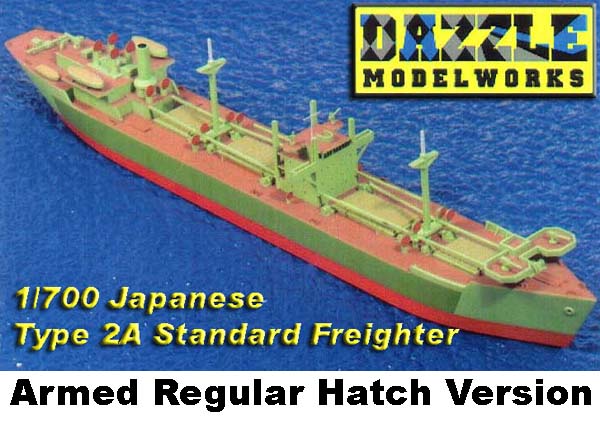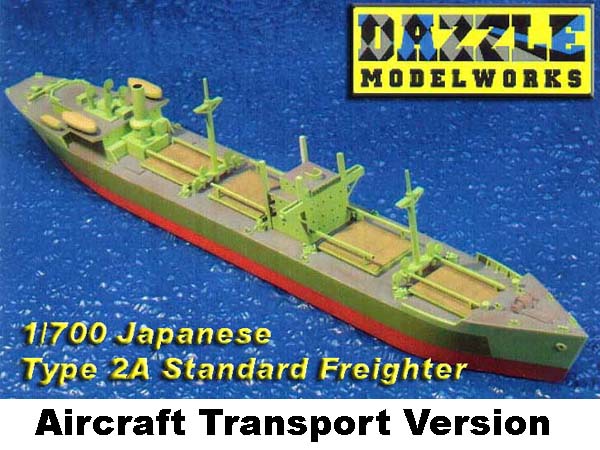
Reviewed by Timothy Dike February 2012 History by Scott Reigel

| HISTORY | |||||||||||||
|
Japan entered the Second World War with a sizable and modern Merchant Marine service with which to perform the dual tasks of transporting raw materials from outlying areas back to the Home Islands for manufacture, and to support the logistics needs of the widely deployed Japanese armed forces. Unfortunately for the Japanese, the near total focus on the offensive operation of the war left few resources and personnel available for protection and support of the logistics infrastructure. As a result, a variety of factors including the slow development of anti-submarine warfare equipment and tactics, a lack of trained personnel for Merchant Marine operations and transport ship construction, and the failure to adopt effective convoy and escort systems resulted in the Japanese incurring the highest merchant marine loss rates of any major combatant in the war. One effort to address the need for additional tonnage was the adoption of standardized ship designs intended for quick production using limited resources by largely unskilled labor. The Type 2A freighter served as the standard large cargo carrier in the program, and was roughly the size and tonnage of an American Liberty Ship. Japanese manufacturing capacity and standards however fell far short of Allied efforts, and in the end only approximately 140 of the 2A type were completed as compared to the 2,700+ Liberties. Even by the standards of wartime emergency construction, the 2Aís were slow, ungainly and lacking quality in almost every detail. Although making some use of welding and prefabrication in their construction, the conscripted workforce used for their shipbuilding ensured that production rates and quality standards would never reach the war plannersí projections. Many features of the 2Aís economy construction are evident with ever a cursory glance: The hull sides and decks were flat, containing neither camber, sheer nor tumblehome in their forms. The large mid-ship deck houses were constructed on shore and lifted into place as completed structures. Cowl vents and funnels for the coal fired boilers were constructed of light sheet metal to be produced in any sheet metal shop. Cargo handling booms were of lattice truss construction and fittings throughout the ship were simplified over earlier designs. Operationally the 2Aís served a variety of roles including bulk freighters, personnel transports and tankers after being fitted with internal oil tanks within the cargo holds. Eight 2A hulls were modified with oversized cargo holds for transport of large items such as aircraft, however by the time they were completed the need to transport warplanes by ship had passed and they were utilized as normal freighters. Losses continued to be heavy, increasing through the end of the war with approximately two out of three of the type being lost before the end of hostilities. Following the war the surviving 2Aís became the nucleus for the Japanís
re-emerging Merchant Marine, often being re-engined and rebuilt in order
to overcome some of the limitations of their wartime origins.
|
|||||||||||||
| Dazzel ModelWorks is a brand new company started by Scott Reigel. This is these two kits are their first offerings. A standard Type 2A Freighter can be built in a wartime or post war version, and the aircraft transport version with it's oversize cargo hatches is also available. | |||||||||||||
| STANDARD FREIGHTER VERSION | |||||||||||||
| HULL | |||||||||||||
| The hull is very cleanly cast in the waterline style that most of us are used to. The only flash on my sample was along the waterline where it is easy to deal with. The deck features a lot of sharp details, from thin bits to nicely molded winch on the bow. The shapes are well defined and details are sharp. This version has smaller hatches typical of most freighters. | Click images
to enlarge |
||||||||||||
|
|||||||||||||
| SUPERSTRUCTURE PARTS | |||||||||||||
| Superstructure parts are well done and the major parts feature sharp details and platforms with difficult to mold overhangs without the typical blobs of resin hiding in the corners. I especially like the brass rod reinforced masts. This will give the parts strength and help them to remain perfectly straight. |  |
||||||||||||
The other parts are cast on a thin resin wafer. This includes
the gun tubs, various platforms, and even the anchors. The latter might
present a little challenge to remove and would have been better molded
on a sprue or runner. Several different sizes and shapes of the gun tubs
are provided to allow you to do most any version of the ship.
|
|||||||||||||
| MISCELLANEOUS PARTS | |||||||||||||
| A nice selection of ventilation pipes are provided along with a bunch of deck winches. Casting is nicely done on each. Canvas covered boats and a nice hollowed out funnel will need very little cleanup. | |||||||||||||
Three deck guns are cast in a protective resin frame with
a little carrier film to trim away. A sharp exacto knife should make short
work of the latter. Several strips of .020 square styrene strip are included
to fabricate the king posts and cargo booms.
|
|||||||||||||
| INSTRUCTIONS | |||||||||||||
The instructions are two pages with built up photos and
assembly notes. This is barely adequate to build this kit and some line
drawings would really help here. There are additional views on the website,
so be sure to check there as well.
|
|||||||||||||
| AIRCRAFT TRANSPORT VERSION | |||||||||||||
 |
|||||||||||||
| This kit will allow you to build that version. It includes the same superstructure and detail parts as the standard version, but the hull is modified. It can be built in armed or unarmed versions. | |||||||||||||
| HULL | |||||||||||||
| The hull is cast very much like the standard version (see notes above). The primary difference are the cargo hatches. Five of the Type 2A ships were modified with larger than normal hatch ways to accommodate bulk cargo such as aircraft. These are noticeably larger than on the standard version. See image on the right for comparison. | Click images
to enlarge |
||||||||||||
 |
|||||||||||||
|
|||||||||||||
| INSTRUCTIONS | |||||||||||||
The instructions are also two pages and laid out as in
the standard version.
|
|||||||||||||
| Conclusions: | |||||||||||||

Dazzle Modelworks, dazzles us with a stunning first entry into the model world. An interesting choice of subjects. One that has been overlooked for far too long. The casting is very good and on a level that suggest that Scott has some experience with pressure casting. I think there is some room for improvement, primarily in the instructions. But if this is the first kit, I can hardly wait to see what comes next. These are kits #DM-10 Japanese Type 2A Maru (Standard Freighter) and #DM-11 Japanese Type 2A Maru (Aircraft Transport) both with a list price of $65.00 US each. A fair price for these unique Japanese freighters. Available direct form Dazzle ModelWorks now. |
|||||||||||||
